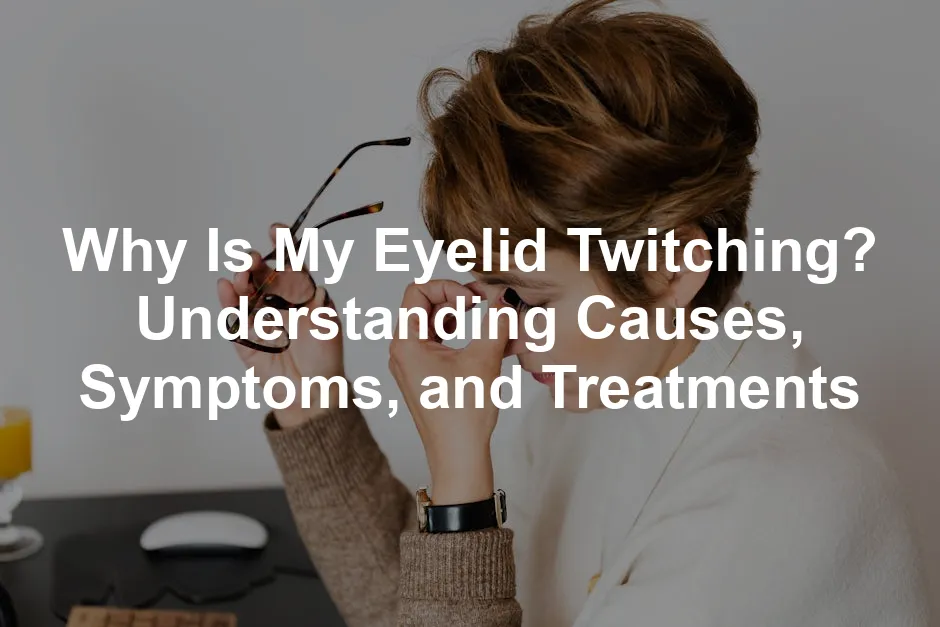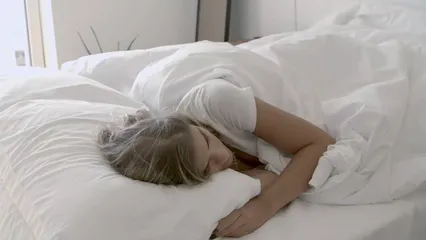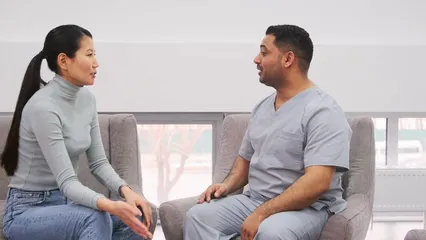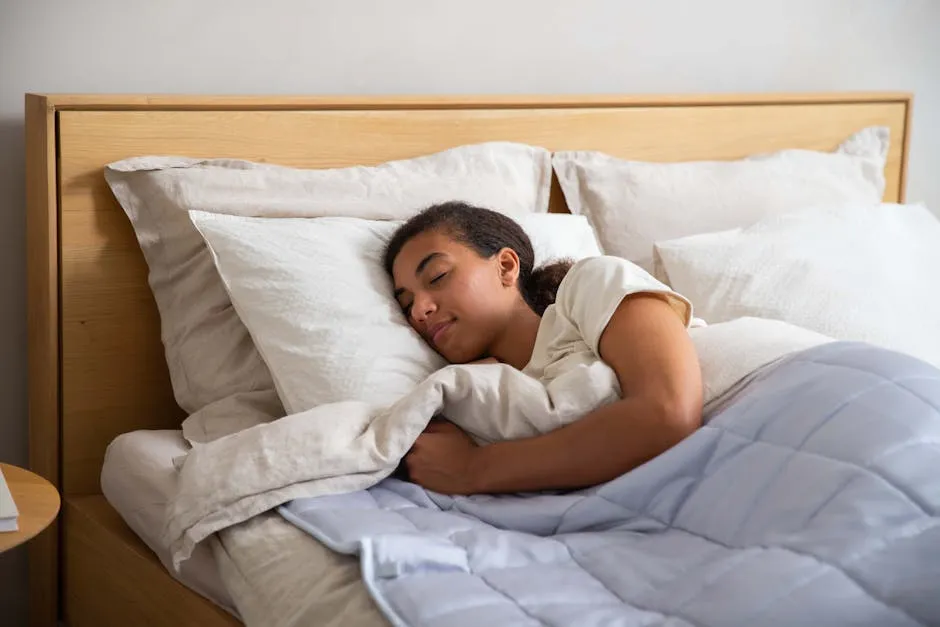
Why Is My Eyelid Twitching? Understanding Causes, Symptoms, and Treatments
Introduction
Have you ever experienced that annoying twitch in your eyelid? Medically, this phenomenon is called myokymia. It’s surprisingly common and can affect anyone. Although usually harmless, it can be distracting and impact your daily life. In this article, we’ll explore the various reasons behind eyelid twitching and discuss the treatments available.
Speaking of distractions, why not try an Essential Oil Blend designed to melt away stress? A whiff of calming scents might just help your eyelids chill out!
Summary and Overview
Eyelid twitching refers to involuntary muscle spasms in the eyelid. These twitches can occur unpredictably and may last for seconds or even weeks. It’s a common experience, especially among people who are stressed or fatigued. Most twitches are benign, meaning they don’t signal serious health issues. However, persistent cases might indicate underlying conditions requiring attention.

This article will cover the common causes, symptoms, and treatment options for eyelid twitching, helping you understand and manage this annoying condition effectively. While you’re at it, consider sipping on a soothing cup of Herbal Tea Variety Pack. It’s like a warm hug in a cup!
Understanding Eyelid Twitching
What Is Eyelid Twitching?
Eyelid twitching happens when the muscles around your eyelid contract involuntarily. This can be triggered by stress, fatigue, or excessive caffeine intake. There are different types of eyelid twitches. Myokymia is the most common type, usually affecting the lower eyelid. In contrast, blepharospasm involves more sustained contractions that may close the eyelids completely. Recognizing these differences can help you address the issue more effectively.
Types of Eyelid Twitches
Myokymia
Myokymia is the most common type of eyelid twitching. It usually affects the lower eyelid and feels like a mild tugging sensation. These spasms can last for a few seconds to several days. Stress, fatigue, and excessive caffeine are key triggers. Environmental factors like bright lights or eye strain can also contribute to these spasms. Generally, myokymia is harmless and often resolves with rest.

Benign Essential Blepharospasm
This condition involves sustained contractions of both eyelids. It typically appears in adults aged 40 to 60, with women being more affected than men. Symptoms may include increased blinking, light sensitivity, and even complete eyelid closure. Over time, this condition can significantly impact daily activities, making it important to seek treatment.
Hemifacial Spasm
Hemifacial spasm is a less common but notable type of eyelid twitching. It primarily affects one side of the face, starting with involuntary contractions around one eye. Symptoms can progress, causing the eye to close and pulling the mouth to one side. The primary cause is pressure from a blood vessel on a facial nerve. This condition affects both men and women, often appearing later in life.
Common Causes of Eyelid Twitching
Stress and Anxiety
Stress can manifest in various physical symptoms, including eyelid twitching. When you’re anxious, your body releases stress hormones that can lead to muscle spasms. Techniques like deep breathing, meditation, or regular exercise can help manage stress levels. Finding healthy outlets for stress is essential for overall well-being. You might even want to try a Meditation Cushion to enhance your calming practice.
Fatigue and Lack of Sleep
Not getting enough sleep can significantly impact muscle function. Sleep deprivation may lead to twitching as your body struggles to recover. Establishing a consistent sleep schedule and creating a calming bedtime routine can improve sleep hygiene. Aim for 7-9 hours of quality sleep each night to help minimize these spasms. A cozy Weighted Blanket can work wonders for a good night’s sleep!

Caffeine and Stimulants
Caffeine is a popular stimulant that can increase muscle contractions. If you consume high amounts of coffee, tea, or energy drinks, it may trigger eyelid twitching. Consider reducing your intake gradually. Switch to decaffeinated beverages or herbal teas to decrease caffeine-related twitching. And hey, if you feel like giving coffee a break, why not try a Caffeine-Free Coffee Substitute? Your eyelids will thank you!
Eye Strain and Irritation
Your eyes work hard every day. Staring at screens can cause eye strain, which often leads to twitching. Common irritants include dry air, pollution, and bright lights. These factors can make your eyelids feel uncomfortable and twitchy.
To prevent eye strain, start by practicing the 20-20-20 rule. Every 20 minutes, look at something 20 feet away for 20 seconds. This gives your eyes a much-needed break. Also, ensure proper lighting when working. Avoid glare from screens by adjusting brightness settings. Using Eye Strain Relief Screen Protector can help too!

Complications of Persistent Eyelid Twitching
When to Seek Medical Attention
Most eyelid twitches are harmless. However, if your twitching continues for over a week, it may be time to see a doctor. Pay attention to accompanying symptoms. If you notice drooping eyelids or twitching in other facial areas, seek medical advice. These signs can indicate a more serious condition. Don’t forget to keep your eyes hydrated with Eye Drops for Dry Eyes!
Associated Conditions
Eyelid twitching can be linked to other health issues. Conditions like dystonia and multiple sclerosis can manifest as eyelid spasms. Dystonia involves involuntary muscle contractions, while multiple sclerosis affects the nervous system. If you have concerns about your symptoms, discussing them with a healthcare professional is essential.

Treatment Options for Eyelid Twitching
Home Remedies
Making a few lifestyle changes can help reduce eyelid twitching. Start by ensuring you get enough sleep. A good night’s rest can significantly ease muscle tension. Additionally, consider cutting back on caffeine, as it can worsen twitching. Relaxation techniques like yoga or meditation can also help relieve stress. Why not enhance your practice with a Yoga Mat?

Natural remedies may provide relief as well. Warm compresses on your eyes can soothe irritation and calm spasms. Staying hydrated is crucial too; drink plenty of water to support overall eye health. If symptoms persist, consulting with a healthcare professional can provide tailored advice and treatment options.
Medical Treatments
If your eyelid twitching becomes bothersome, medical treatments may help. One popular option is botulinum toxin injections. These injections can temporarily paralyze the muscles causing the twitch. They usually provide relief for several months. However, you may need repeat treatments to maintain results.
In some cases, medications might be necessary. These can range from muscle relaxants to antiepileptic drugs. Surgery could be an option if other treatments fail. This typically involves removing or altering the muscles around the eyelids. Consulting a healthcare professional is essential to determine the right course. You might also consider utilizing a Sleep Sound Machine to promote better rest!

Lifestyle Adjustments
Making simple lifestyle adjustments can significantly reduce eyelid twitching. Start by maintaining a balanced diet rich in vitamins and minerals. Foods high in magnesium, like leafy greens and nuts, may help muscle function. Hydration is equally important. Drink plenty of water to keep your body nourished. You might want to consider Magnesium Supplements for an extra boost!

Managing screen time is crucial as well. Too much exposure can lead to eye strain, a common trigger for twitching. Try the 20-20-20 rule: every 20 minutes, look at something 20 feet away for 20 seconds. Additionally, reducing environmental irritants, like bright lights or dry air, can help create a more comfortable space for your eyes.
Preventing Eyelid Twitching
Identifying Triggers
To prevent eyelid twitching, it’s vital to identify your triggers. Keeping a symptom diary can provide valuable insights. Note when the twitches occur and what you were doing at the time. This can help you pinpoint stressors or lifestyle habits that contribute to the problem.

Once you’ve identified your triggers, implement strategies to avoid them. If stress is a factor, consider relaxation techniques like yoga or meditation. Reducing caffeine and ensuring adequate sleep can also decrease the likelihood of twitching. A Sleep Mask can also help you get the Zzz’s you need!
Healthy Lifestyle Choices
Adopting healthy lifestyle choices can promote overall well-being and reduce eyelid twitching. Regular exercise is essential. Aim for at least 30 minutes of physical activity most days of the week. This can help manage stress and improve sleep quality. Want to track your progress? A Fitness Tracker Watch can be your new best friend!

Staying hydrated is equally important. Aim for eight glasses of water a day to keep your body functioning well. Finally, pay attention to your nutrition. A well-balanced diet can support muscle health and overall wellness, minimizing the chances of twitching.
Conclusion
Eyelid twitches are usually harmless and often resolve on their own. However, if your twitching lasts longer than a week, it’s wise to consult a healthcare professional. Persistent symptoms might signal a more serious condition.
Understanding your personal triggers is vital. Stress, fatigue, and caffeine can all contribute to these annoying spasms. Managing lifestyle factors can greatly reduce the frequency of twitches. You might even want to enhance your relaxation routine with an Aromatherapy Diffuser!
If you experience ongoing or severe symptoms, don’t hesitate to seek professional advice. A healthcare provider can help determine the best course of action for your situation.
FAQs
Can eyelid twitching be serious?
Most eyelid twitching cases are benign. However, see a doctor if the twitching persists for more than a week or if you notice drooping eyelids.
What are the common triggers for eyelid twitching?
Stress, lack of sleep, and excessive caffeine consumption are primary triggers for eyelid spasms.
How is eyelid twitching diagnosed?
Diagnosis typically involves discussing your health history. A physical examination will assess your eye and nervous system.
What treatments are available for chronic eyelid twitching?
Treatments include medications and therapies like botulinum toxin injections, which can help reduce symptoms.
Are there any natural remedies for eyelid twitching?
Lifestyle changes such as better sleep, stress management, and reducing caffeine may alleviate symptoms effectively.
Please let us know what you think about our content by leaving a comment down below!
Thank you for reading till here 🙂
If you’re curious about the reasons behind your eyelid twitching, understanding why your eyelid might be twitching can provide valuable insights.
All images from Pexels




